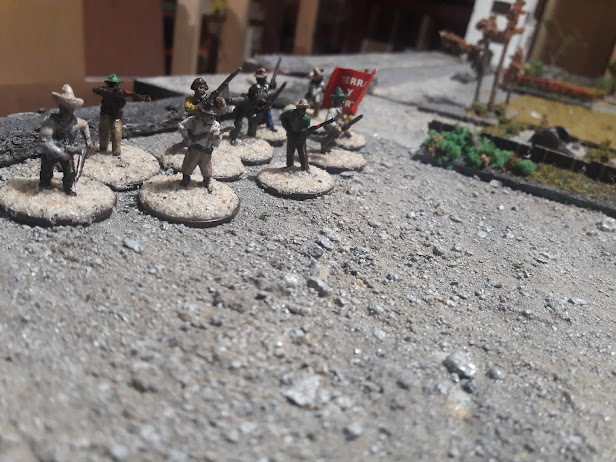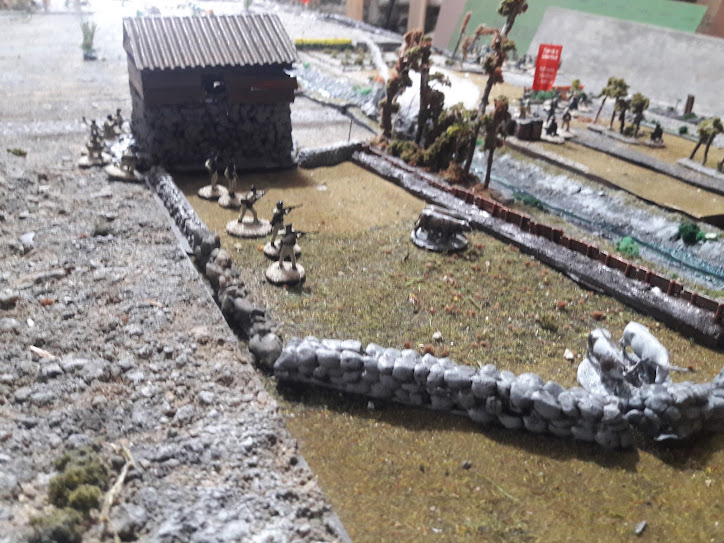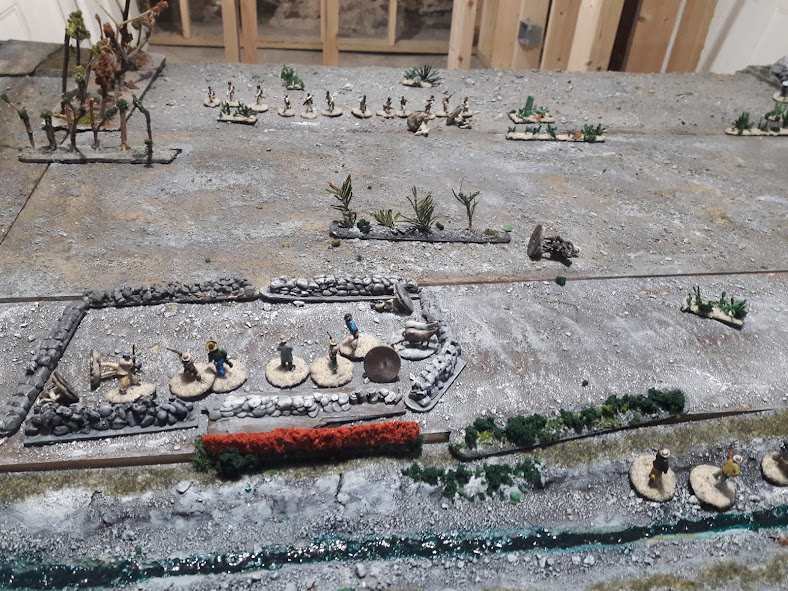Here is a report from a game I recently played based on Scenario 4, from my campaign, Sueños de Libertad. This scenario is based on the first real battle the Liberal Army in Baja fought during the 1911 insurrection, as most of the operations until then were conducted by small guerrilla groups raiding towns. The game was larger and took longer than the previous scenarios, saw the front lines moving back and forth while units routed and rallied, and paralleled, in some ways, the actual battle that took place on a February day one hundred and ten years ago.

Jimenéz's cavalry group hid out at Little's Ranch on the south flank, waiting in ambush.
Behind the cavalry, Leyva's first group dug in on the canal bed around the stone bridge.
They could not see through the torrential rainstorm, but three government platoons approached the ranch. From north to south: a platoon of conscripted "volunteers," a Federal platoon, and a group or Rurales.
Three more platoons, --two Federal soldiers and another of conscripts-plus Colonel Vega's headquarter group, entered the table on the north side of the line.
The conscripts on the government's left flank were led by a Federal officer and some wealthy business men and their goons.
Leyva's second group awaited them, dug in by the canal on the north flank.
In this second group was William Stanley and other volunteers from the Industrial Workers of the World union, volunteering from north of the border.
Colonel Vega moved to organize his forces for the attack. He marched his command group to the peak of the mountain for a better view.
He ordered his first platoons into action. A Federal and a conscript platoon each charge down the mountain toward Mexicali.
On the other end of the table, Vega's Rurales charged up the road toward the bridge. Jiménez's squad remained hidden behind the barn.
The Liberal Army, hearing the approaching footsteps, prepared to do battle. They placed hats on sticks to draw their enemy's fire. To represent this tactic, before each Government volley, I rolled 1 D6. The resultant number represented these decoys, and I subtracted the number from the hits the government landed.
The first objective for the revolutionaries was to destroy the two bridges across the Rio Nuevo. They quickly lit the northern bridge alight, and, it being built of wood, the structure caught quickly.
At the southern bridge, a revolutionary planted dynamite, and lit the fuse. The fuse would burn for the length of 1 round, so the comrades backed away to safe distances, and hoped the fuse would burn right.
Back at the north end of the line, the Liberals prepared to fire on the attackers.
The rebels opened fire on the figures appearing through the sheets of rain, killing the first three soldiers. The platoon of soldiers continued their steady charge.
Just to their south, a platoon of conscripts crossed the desert to join the assault on the northern end.
On the next turn, the Leyva moved the command group up toward the line, and sent a section of the first group forward to take advanced positions in the donkey corral.
The first platoon of soldiers reached the defensive line in front of Stanley's section.
The advanced platoon of Federal soldiers was joined by a group of conscripts on its right.
And another on the left.
The beleaguered defenders miraculously shot down enough of the advancing conscripts in its first volley to halt the attack. With low morale to begin with, after their Federal officer died, the conscripted men on the northern flank routed easily. They fled back up the mountain. The Federal platoon and the second group of conscripts held their positions. They took casualties, but also inflicted a few on the defenders.
On the south end, the Rurales just reached the stone bridge. It must have seemed to quiet for them, as the Magónistas hid behind stone walls and laid low in the Rio Nuevo.
Their timing could not have been worse. Just as the first officers crossed the bridge, the fuse ignited the dynamite, destroying the bridge.
The rebels mowed down many of the surviving Rurales as they fled toward the line of Federals, advancing slowly.
In the following round, back on the north end, the battle raged on. The Magónista right flank, having seemingly broken the first group of conscripts, shifted downward to meet the two government platoons charging the canal bed, just south of the burning bridge.
The combined fire of Liberal Army Group 1 caused many casualties and killed the leaders of both opposing platoons. The attackers broke and fled back into the desert.
Colonel Vega, however, managed to end the flight of the "volunteers." They spent the next turn rallying to attempt another attack.
As the next round began, a new platoon of Federal soldiers enters the table west of Little's Ranch. South of them, Jiménez has just led his cavalry group out of hiding and into the opponent's rear.
Jiménez's group hooked around and attacked the south flank of Vega's line. The horsemen caused four casualties, but lost one rider themselves before they retreated back to Little's ranch.
PLM group 2 remained quiet throughout the next round as the Government forces reorganized. Colonel Vega detached his Machine-gun crew to set up at the top of the mountain, and led the rest of the headquarters section into the desert. He hurried to intercept the fleeing platoons, and prepared a new assault, this time on the center of the rebel line.

Vega was able to pull together a strong attack force, and spread them across the center of the table, linking up with the platoon already lined up on the south end.
A small section of Liberal Army Group 1, lined up in the advanced position of Little's donkeys' pen, would the brunt of the attack.
On the north flank, Vega's conscripts have already begun the second wave. The group crossed the open desert into the canal section abandoned earlier by the Magónistas.
Meanwhile, the fighting began at Little's donkey enclosure. Magónistas tore into the advancing ranks of Federales, but the rebels took many casualties themselves and began to waver.
To their south, the rebel cavalry group set out again along the flank and into the rear of the enemy.
In the following round, the conscripts took control of the north section of the canal.
The canal defenders, however, caught sight of the attack and moved back into favorable positions. They rained fire down upon the tired and frightened conscripts, once again causing them to flee.
Back on the south flank, Jiménez's cavalry reached the back edge of the table and dispatched the few surviving Rurales, who had just rallied to return to the front. Behind them, a group of Federales reached the Little barn. Just north, the two Federal platoons reached the donkey enclosure. While the revolutionaries there shot many soldiers, they could not hold the front wall. They retreated to the outside wall of the pen and returned fire.
In the following turn, the army advanced further into the center of the table. The two platoons on the south end of the line pushed the rebels at the donkey enclosure down into the canal and back out the other side. A third platoon, just north of this action, managed to charge right into the canal, splitting the defending force in two.
The PLM rebels held strong in the face of this advance. The headquarters section moved up to fire on the soldiers in the canal. Many federal bullets were wasted firing at hats on sticks. Even still, the rebels were sorely outnumbered. As they fired at the attackers, the flashes of their rifles give away their positions to the machine gun on the mountain, which fired on their lines.
On their left, the second group of conscripts rallied and approached the line. They fired into the canal as well. Vega and the command group directed the attack from the center of the table, out in the open.
Behind them, a second platoon of Rurales arrived on the hill.
Led by a cavalry squad, They're orders are to immediately charge down the mountain to support the conscripts, and the push on the canal.
In the next round, Jiménez's group charged down the back of the table. They reached the unsuspecting headquarters group, and fired on Vega and his men.
The Colonel and most of his headquarters fell in the first volley. The rebel cavalry continued north, leaving Vega lying in the desert sand. The government forces, left without clear leadership, spent a few rounds before the platoon commanders could sort out who was in charge and to issue new orders. At that point, however, Federal platoons were already engaged in charging the canal all along the line. They had no way to know that their Colonel was out of commission.
The second Magónista group managed to break the charging conscripts, and sent them running back into the desert. They could not, however, drive the Federal platoon out of the canal. Though these soldiers took substantial losses, they refused to flee, and continued to fire upon the defenders in the canal bed. The Rurales platoon was on the way to help. Jiménez's cavalry attempted to harass the Rurales, and managed to drop a couple officers, but they lost riders as well and were forced to turn back. The Rurales came down out of the mountain.
On the next round, the Rurales stormed across the canal. Desperate fighting ensued, and the outcome of the entire battle seemed to hang in the balance.
On the south end of the line, the Federals at Little's advanced. The group on the road fell into an ambush, as the insurrectos had returned to the edge of the ranch.
Leyva and the rebel command group, observing the action from the center of the table, decided that now was the time to call for reinforcements. A third group of twenty-five rebels was waiting off table, and now that there were enough weapons dropped by fallen fighters lying around the canal to arm these men, Leyva sent a runner to call them up. As the messenger departed, Leyva brought his HQ toward the farm house, where it seemed safest.
The charge of the mounted Rurales killed a number of rebels on the north flank, and drove that section out of the canal and up the hill. The survivors regrouped there, and returned fire down on the horsemen with deadly effect. The other section of Liberal Army group two held strong in the face of the government's attack. Most of the Rurales cavalry was destroyed, but the officers behind them continued coming, and the soldiers in the canal bed refused to break.
Just then, the third group of the Liberal Army of Mexicali arrived. Leyva ran out to meet them, and directed them into the canal bed at the center of the table.
Just across the Rio Nuevo, the officers of the two platoons on the south flank finally worked out who was in charge. The new commander ordered the soldiers to advance into Little's Ranch.
The officer ordered the other platoon into the donkey corral.
Behind them, the insurrection cavalry came charging back toward the line. They fired on the soldiers in the donkey pen, but landed few hits.
When the soldiers returned fire, another horseman died, and the survivors fled back across the frontline.
With the threat behind them removed, the two Federal platoons continued to advance through Little's Ranch, and took up firing positions at the stone walls closest to the Rio Nuevo canal bed. The anarchists in the canal fired on the soldiers, but the Federals now had the advantageous position, and fired down into the canal, causing the rebels to abandon their positions.
For the rebels, things were just as bleak on the north end of the frontline. While William Stanely's IWW volunteers finally managed to finish off the few Federales in the center of the canal, the officer of the first Federal platoon, dug in on the mountain, was able to rally the fleeing conscripts, who returned for a third attempt.
The IWW group traded shots with the Rurales, but neither would budge. This, the bleakest moment in the entire engagement for the insurrectos, is when the third Liberal Army group entered the fight
The third group ran into the canal. The Rurales, suddenly out-maneuvered and outnumbered, were doomed. When the officers broke, the rebels continued north to fire on the conscripts on their right flank. This grouping, having routed twice already, had -3 morale. They broke again as soon as they began taking casualties.






















































































No comments:
Post a Comment